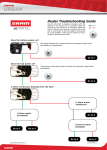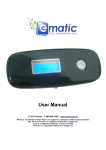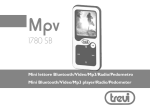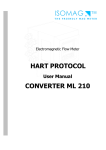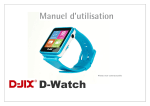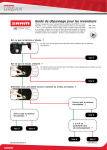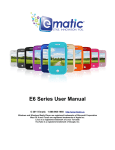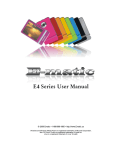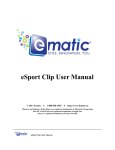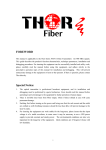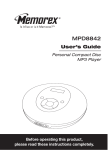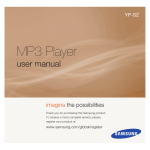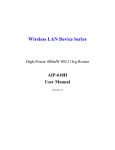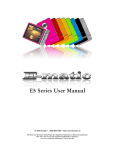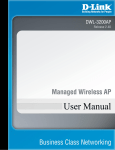Transcript
User Manual Part II: Player Operations Table of Contents 1.0 5.0 Basic Operations .....................................................................................................................16 10.1 Entering E-Book Mode................................................................................................ 26 5.1 Turning the Player On and Off ....................................................................................16 10.2 Basic E-Book Operations............................................................................................ 26 1.1 Foreword ....................................................................................................................... 4 5.2 Mode Selector .............................................................................................................16 10.3 E-Book Menu .............................................................................................................. 26 1.2 Package Contents......................................................................................................... 4 5.3 Changing the Volume.................................................................................................. 17 1.3 Warnings ....................................................................................................................... 4 1.4 1.5 3.0 4.0 Radio Operations ........................................................................................................ 28 Computer Requirements............................................................................................... 5 6.1 Entering Movie Mode .................................................................................................. 17 11.2 FM Radio Menu .......................................................................................................... 28 Layout of the Player ...................................................................................................... 6 6.2 Video Playback ........................................................................................................... 18 6.3 Movie Menu ................................................................................................................ 19 Connecting and Disconnecting the Player from Your Computer .................................. 8 2.2 Charging the Battery ..................................................................................................... 9 7.0 Video Conversion ...................................................................................................................... 9 3.1 Installing Video Conversion Software ........................................................................... 9 3.2 Converting Video...........................................................................................................10 3.3 Using Other Conversion Software ................................................................................ 11 3.4 Converting Video in Linux ............................................................................................. 11 Copying Files ............................................................................................................................. 12 4.1 Copying Media Files to your Player .............................................................................. 12 4.2 Using Windows Media Player's® Sync Function.......................................................... 13 8.0 9.0 Listening to Audio ....................................................................................................................20 7.1 Enter Music Mode ....................................................................................................... 20 7.2 Audio Playback ........................................................................................................... 21 7.3 Audio Playback Menu ................................................................................................. 22 7.4 Audio File Menu ......................................................................................................... 22 12.0 14.0 Viewing Pictures ......................................................................................................................23 8.1 8.2 Entering Photo Mode .................................................................................................. 23 Picture Viewing Operations......................................................................................... 23 8.3 Photo Menu ................................................................................................................24 Device Settings........................................................................................................................29 Miscellaneous 13.0 15.0 1.1 Understanding File systems........................................................................................ 31 13.2 Reformatting Your Player in Windows ........................................................................ 31 Help .....................................................................................................................................32 14.1 Troubleshooting .......................................................................................................... 32 14.2 For More Help .............................................................................................................33 Entering Recorder Mode............................................................................................. 24 9.2 Voice Recorder Operations......................................................................................... 25 1.2 Package Contents Your player comes with the following items: The player A USB cable 1.3 2.0 2.1 Do not use the product in extreme temperatures, or dusty or wet environments. Do not leave the product in direct sunlight. Do not disconnect the player and USB from your computer without first ensuring a “safe removal,” as this may damage the player. See pg 8. Do not open or disassemble the player, as this will void the warranty. Handle the player with care to prevent physical damage. Protect the player from static discharge. 2.2 Connecting and Disconnecting the Player from Your Computer To safely disconnect the player from your computer, click the green arrow in the system tray (the area by the clock in your task bar), which will display a list of attached USB devices. Click the player in the list. Windows will display a message when it is safe to remove the player. 6 7 7 4. Build a list of videos to convert. Click the green icon next to the Input File field, navigate to your media folder(s), and select one or more videos to convert (Note that the program will not convert from any video format). Once a video is selected, it will be added to a file list at the bottom of the window. Repeat the Add File process until you have completed your list of videos to convert. 5. Once the list is complete, click the Begin button ( ) to start converting the list of videos. A message will appear when the list is complete. 3.3 4.0 4.1 Using Other Conversion Software Follow these steps to copy media files to the player under OS X: 3. Open the player’s root folder: Double-click My Computer, then doubleclick the drive that corresponds to the player. It will probably be labeled Removable Disk. The unit will also turn itself off if its battery power becomes too low. ® If you sync your player with Windows Media Player, follow these steps when initially syncing the device: Changing the Volume 6.2 Audio Playback Audio Playback Menu 8.0 Viewing Pictures 8.1 Entering Photo Mode Audio File Menu Pause or Resume by pressing the PLAY/PAUSE button. Skip to the previous or next song by pressing the PREV or NEXT buttons. Fast-forward or Rewind playback by holding the PREV or NEXT buttons. Change Volume by first pressing the VOL button, then using the PREV and NEXT buttons to change the volume. Access the Audio Playback Menu by pressing the MENU button • Change the file or folder you’re listening to by selecting ‘Local folder,’ then selecting a new file/folder to listen to. • Access playlist options by selecting the ‘Repeat’ menu. • Delete one or all files by selecting ‘Delete file’ or ‘Delete all.’ • • • Change the txt file folder by selecting ‘Local folder,’ then selecting a new folder to view txt files from. Switch between Manual and Automatic scroll modes by selecting ‘play set.’ When viewing txt files with auto mode on, the player will automatically change pages after a few seconds. Delete one or all files by selecting ‘Delete file’ or ‘Delete all.’ Selector, then press the MENU button to enter the mode. You can change the txt folder and see a list of other E-book viewing options by pressing the MENU button to access the E-book Menu. 10.3 E-Book Menu 13.2 Reformatting Your Player in Windows Follow these steps to reformat your player: 1. Connect the player to your computer via the USB cable. 2. Double-click My Computer. Find the icon representing the player, which will probably appear as Removable Disk. 3. Right-click the player's icon and select Format. 4. Make certain the file system is FAT32; otherwise the player will not work! 5. Click Start. 6. When the Warning message appears, click OK. Once started DO NOT remove the USB cable as this may damage the player! 7. Once the formatting is complete, you may access the drive through My Computer. 31 Photo Menu To enter the Photo Menu, press the MENU button while viewing the list of picture files. From the Photo Menu, you can do the following: After entering Photo mode, the player will automatically display a list of picture files contained in its root folder. Use the PREV and NEXT buttons to scroll through the file list, and the PLAY/PAUSE button to select a picture to view. • Switch between Manual and Automatic scroll modes by selecting ‘play set.’ When viewing photos with auto mode on, the player will automatically change photos after a few seconds. You can change the folder and see a list of other picture viewing options by pressing the MENU button to access the Photo Menu. • Delete one or all files by selecting ‘Delete file’ or ‘Delete all.’ At any time in Photo mode, you can press and hold the MENU button to return to the Mode Selector. 8.2 Picture Viewing Operations While viewing a picture: Skip to the previous or next picture in the current folder by pressing the PREV or NEXT buttons. Press the PLAY/PAUSE button to return to the list of picture files. Unit spontaneously turns off Player connected by USB, but computer does not recognize the device After entering Music mode, the player will automatically queue the songs it finds in its root folder. When audio playback is stopped or paused, you can select a different file or folder to listen to by pressing the MENU button and accessing the Audio File Menu. See Audio File Menu on pg. 22 for more information. Solution Recharge the battery for 4 hours Switch player off and then on again Weak battery Recharge the battery for 4 hours USB cable damaged USB is disabled in the BIOS Replace with a new cable Enable USB functionality in the BIOS OS does not support USB Install or update the OS driver Wire wrongly connected Make sure the cable is firmly connected Reboot PC Volume is too low Unsupported file format Turn up the volume Re-encode media in a supported format The file is corrupted Damaged earphones Re-copy the file to the player. You may have to re-encode the file. Use different earphones Format failure Format with a FAT32 file system Doesn’t save; “Save Failure” Storage full Wrong save path Delete some files from the player Double-check the destination folder Wrong language Songs on player are not in playable list Wrong language is configured Songs in the wrong folder Change the language in Settings Move all song files to the player's root folder, or one of its subfolders 32 Voice Recorder Operation The Voice Recorder has the following functionality: • Press the PLAY/PAUSE button to start voice recording. Press the PLAY/PAUSE button again to pause/resume the recording. • Save a recording by holding the PLAY/PAUSE button until the timer resets. • Press the MENU button to access the Recorder Menu. From the Recorder Menu, you have the following options: Entering Record Mode - Change the recording quality by selecting ‘REC type.’ REC means the recording will continue until you tell it to stop. VOR means the recording will stop when silence is detected. To access voice recording, highlight the Record mode in the Mode Selector, then press the MENU button to enter the mode. At any time in Record mode, you can press and hold the MENU button to return to the Mode Selector. 24 You can listen to the recordings you make by returning to the Mode Selector and choosing the Voice mode (Which has the same basic functionality as Music mode). 25 Auto Search scans all available frequencies and saves all stations whose signal is strong as presets Normal Band sets the player to use US radio station frequencies Tune using the PREV and NEXT buttons • Skip to the next preset by pressing the PLAY/PAUSE button • Access the FM Radio Menu by pressing the MENU button • Change the Volume by pressing the VOL button (see ‘Changing the Volume’ on pg. 9 for more information) Japan Band sets the player to use Japanese radio station frequencies 12.0 Device Settings Use the Mode Selector to enter Setup mode. The following settings are available: LCD set allows you to select the amount of idle time before the backlight turns off Language allows you to change the display language. Supported languages are listed under “Technical Specifications” on pg. 34 Power off allows you to change the amount of idle time before the player automatically turns itself off Delete all deletes all preset stations and returns the FM Radio Menu to its default layout Memory Info displays the player’s memory information. Firmware ver displays system’s firmware version 29 15.0 Technical Specifications See the FAQ page on our website for information and how-to videos: http://www.ematic.us Check the Updates section of our website. View how-to videos on our website. E-mail customer service: [email protected]. You can expect a response within 1-2 business days. Dimensions Display USB Memory Record MP3 and WMA Supported formats Operating temperature Menu language 33 Miscellaneous System time sets up the date and time Delete If you are listening to a station that has been saved as a preset, you can delete the preset by selecting this 14.2 For More Help Possible Reason Weak battery Invalid operation 9.2 9.1 While listening to the radio: • 20 - Change the folder that recordings are saved to by selecting ‘Local folder,’ then selecting a new folder to save recordings to. 28 Any issues of the PC No sound when playing media To access audio playback, highlight the Music mode in the Mode Selector, then press the MENU button to enter the mode. Recording Audio Exit returns to the Mode Selector Problem Unit will not turn on Entering Music Mode 9.0 11.1 Radio Operation 27 14.0 Help 14.1 Troubleshooting Your player is like a small hard drive of data, and like any such storage device, it has a file system. If you wish to reformat the player's file system, you may use any standard formatting tools as long as it is formatted with FAT32 file system. 8.3 Save If you are listening to a station that has not been saved as a preset, select this to save the station as a preset While viewing a text, use the PREV and NEXT buttons to read. You can also access a list of bookmarking options by pressing the MENU button. 13.1 Understanding File systems 7.1 19 While listening to the radio, press the MENU button to enter the FM Radio Menu. From the FM Radio Menu you have the following options: FM radio will only work with headphones plugged in, as they function as the antenna. 26 Listening to Audio Press the PLAY/PAUSE button to exit the video menu, or hold the MENU button to return to the Mode Selector. 11.2 FM Radio Menu 10.2 Basic E-Book Operations 13.0 Formatting the Player Delete one or all files by selecting ‘Delete file’ or ‘Delete all.’ Change the picture folder by selecting ‘Local folder,’ then selecting a new folder to view pictures from. To listen to FM Radio, highlight the FM Radio mode in the Mode To enter the E-book Menu, press the MENU button while viewing the list of txt files. From the E-book Menu, you can do the following: • 23 11.0 Listening to the FM Radio At any time in E-book mode, you can press and hold the MENU button to return to the Mode Selector. Access playlist options by selecting the ‘Repeat’ menu. • 22 21 • 7.0 At any time in Music mode, you can press and hold the MENU button to return to the Mode Selector. To access picture viewing, highlight the Photo mode in the Mode Selector, then press the MENU button to enter the mode. When audio playback is stopped or paused, you can enter the Audio File Menu by pressing the MENU button. Use the PREV and NEXT buttons to scroll through the menu, and the MENU button to select. From the Audio File Menu you can do the following: After entering E-book mode, the player will automatically display a list of txt files contained in its root folder. Use the PREV and NEXT buttons to scroll through the file list, and the PLAY/PAUSE button to select a txt file to view. Skip to the previous or next video file by pressing the PREV and NEXT buttons. Fast-forward or Rewind by holding the PREV or NEXT buttons. Change the file you’re viewing by selecting ‘Local folder,’ then selecting a new file to watch. 18 While audio is playing, press the MENU button to access the Audio Playback Menu. From the Audio Playback Menu, you can select the following functions: 7.4 To access E-book viewing, highlight the E-book mode in the Mode Selector, then press the MENU button to enter the mode. • • 15 Changing the volume can only be performed in Movie mode when video playback is not in progress. Change the Volume as described in “Changing the Volume” on pg. 17 Repeat allows you to select a playlist repeat option such as Random (shuffle) or Repeat one (play the same file over and over) Equalizer allows you to select an equalizer preset Tempo rate allows you to change the tempo of the music 10.1 Entering E-Book Mode Play or Pause a video by pressing the PLAY/PAUSE button. 17 7.3 10.0 E-Book Operations • • This player will only play videos that have been converted to the compatible video format. See “Technical Specifications” on pg.34 for a list of supported formats. See pg.10 for information on Video Conversion. During audio playback, the player has the following functions: Enter the Movie Menu by pressing the MENU button while in Movie mode. Use the PREV and NEXT buttons to scroll, and the MENU button to select. From the Movie Menu you can do the following: During video playback, the player has the following functionality: 16 7.2 Movie Menu Video Playback The Mode Selector In all viewing/listening modes, press and hold the MENU button to return to the Mode Selector. 6.3 At any time in Movie mode, you can press and hold the MENU button to return to the Mode Selector. Entering Movie Mode The player has many functions, or modes, including playing audio/video media and viewing pictures. When the player is turned on it displays the Mode Selector (Main Menu), which can be used to enter any of these modes. Browse the modes with the PREV and NEXT buttons. Select a mode with the MENU button. 14 When entering Movie mode, the player will automatically queue the first video it finds in its root folder. Select a different video to watch by pressing the MENU button and accessing the Movie Menu. See Movie Menu on pg. 19 for more information. 6.0 Watching Videos 6.1 Note: See the full list of supported formats under “Technical Specifications” on pg. 34 to determine which synced songs will be supported by the player. 13 In Music, Movie, Voice or Radio mode, the volume can be changed by pressing the VOL button and using the PREV and NEXT buttons to change the volume. Exit the volume menu by pressing either the PLAY/PAUSE or MENU buttons. Part II: Player Operations 1. Turn the player ON and use the USB cable to connect it to your computer. Turning the Player On and Off instructions indicate whether 10 Using Windows Media Player 11's Sync Function To watch videos, highlight Movie mode in the Mode Selector. Enter the mode by pressing the MENU button. to press or press and hold a By default, if the player is left idle for more button! than two minutes, it will turn itself off. The player can be configured to turn off after a different duration, or not at all, by accessing the player’s Setup mode (See “Device Settings” on pg. 29). You can save the converted files to your computer and copy them to the player later, or select your player as the output directory and save them directly to the device itself. 4. If you want to manually sync the player, click the Sync tab. Highlight the files you want transferred to your device, drag them into the Sync List column, and then click Start Sync to begin transferring them to the player. When the process is complete, you should be able to see the song files on the player through My Computer. 6. Disconnect the player from the computer by dragging the Removable Disk icon to the Trash/Eject icon in the dock. Basic Operations 5.3 3. Choose a folder in which to save the converted files by clicking the red icon beside the Output File field. This player will only play videos that have been converted to a compatible video format. 3. If you want Windows to automatically sync your player, right click the Sync tab, highlight the player’s name with the mouse cursor, and then click Set Up Sync from the submenu that appears. In the Device Setup window, click the box next to Sync this device automatically, add or remove playlists you want to sync from the playlists to sync box, and then click Finish. 5. Drag-and-drop media files from your computer's window to the player's window. 12 To turn the player ON, press and hold the PLAY/PAUSE button until the display turns on. Pay special To turn the player OFF, press and hold the PLAY/PAUSE button until the display turns off. attention to whether these 2. Run the conversion software by clicking Start > Programs > Media Player Utilities > AMV Video Converter. 2. Run Windows Media Player. If this is the first time connecting the player to Windows Media Player, the program will ask you to name the device. Choose a name and click Finish. 4. Using the same process, open a finder window to your music, video, or other media files. 4. Open the folder(s) containing your music, video, or other media files. 11 5.2 Before watching videos on your new player, they must first be converted to the format recognized by the player. This conversion can be done with Windows software that came included with your player. Follow these steps to install the software: 3. Open a finder window to the player: Double-click the Removable Disk drive that appears on the Desktop. It will probably be labeled No Name. 4.2 Note: You cannot convert copyprotected DVDs. 1. Connect your player to your computer using the USB cable if you wish to save directly to the player. Video Conversion Installing Video Conversion Software 2. Connect the player to your computer with the USB cable. 2. Connect the player to your computer with the USB cable. While the player doesn’t come with conversion software for either OS X or Linux, there may be free, open-source programs on the internet that can do the necessary transcoding. 5.1 3.0 3.1 1. Switch the player on. 1. Switch the player on. Converting Video To play videos on your player, you must (a) have some videos on your computer, (b) convert them to the format supported by the player, and then (c) copy the video files to your player. 3. For normal use, charge the player for 4 hours. 6. Disconnect the player from the computer using the safe removal method described on pg. 7 Follow these steps to copy media files to your player in Windows: 3.2 9 Copying Files Converting Video in OS X & Linux 5.0 Any USB device that stores data (e.g. flash drives, cameras, and media players) should always be disconnected from your computer using this method! 5. Drag-and-drop media files from your computer's media folders to the player's folder. Make certain your media files are supported by the player. AAC encoded Media from iTunes is NOT supported 3. Complete the installation as directed by the installation wizard. If Windows asks you whether to allow the installation, click ALLOW. Follow these steps to convert video files: We recommend using http://media-convert.com/ for converting to .AMV because it requires no downloading, and runs in your favorite internet browser. Regardless of what convertor software you use, make sure that you convert videos to AMV format, at a resolution of 128x128. To listen to and/or view media on your player, you must first copy the files from your computer to the player. Before copying files to your player, however, you must make certain that the files you wish to enjoy have been converted to the correct format. Read about video conversion on pg. 10 2. Double-click Msien.msi to perform the installation. 2. For first time use, charge the player for 10 hours. 8 Copying Media Files to your Player While the included software converts numerous formats to the format required by the player, there may be some formats that it cannot convert. In many cases, however, you can find other free software on the Internet that can do the job. Regardless of what convertor software you use, make sure that you convert videos to AMV format, at a resolution of 128x128. See the player’s complete format information under “Technical Specifications” on pg. 34. 3.4 1. Connect your player to your computer via the USB cable. Charging will begin. 8 6 1. Click My Computer> Click Ematic Tool(mini CD) > Click AMV Video Converter, and then you can see Msien.msi installation file. The player has a built-in battery that must be charged before the player can be used. Before initial use of the player do the following to ensure longer battery life: The first time you connect the player to your computer; your computer will detect it and automatically install any necessary drivers. When it has finished, the player will appear in My Computer as Removable Disk or USB Disk Device. EM144VIDG 4GB 5 Charging the Battery Turn on the player and use the included USB cable to connect it to your computer. Plug the small end of the USB cable into the player, and the large end into your computer. Part I: Computer Operations If the screen freezes, please power off the device and power it on again by pressing power off/on button on the bottom of the player One pair of stereo headphones This user manual A quick-start guide 4 Connecting and Charging the Player ® Warnings 3 Layout of the Player ® Windows 2000/ME/XP/Vista An 800MHz or faster CPU USB port CD-ROM drive At least 50MB free hard disk space Please visit our website for more information: www.ematic.us Technical Specifications ..........................................................................................................34 2 1 ® player. These include Windows , Mac OS X , and Linux . The following, however, is required in order to use the included video conversion software: Thank you for purchasing this player. Please read this manual carefully before using the product. Specifications and software updates are subject to change without notice. The player pictured in this manual may differ from yours, but the information in this manual will still apply. Recording Audio ......................................................................................................................24 9.1 Computer Requirements Virtually any computer and operating system that is able to use USB storage devices can be used to copy files to and from the Foreword Formatting the Player ..............................................................................................................31 13.1 1.4 Introduction Listening to the FM Radio .......................................................................................................27 11.1 2.1 1.5 11.0 Watching Videos......................................................................................................................17 Connecting and Charging the Player ........................................................................................ 8 6.0 1.0 E-Book Operations ..................................................................................................................26 Introduction ................................................................................................................................ 4 Part I: Computer Operations 2.0 10.0 83mm x 40mm x 8mm (length x width x thickness) Physical dimensions 1.5” screen Resolution 128x128 pixels USB 2.0 Internal file system FAT32 Format WAV Length 300 Hours (4GB) Compress rate 32Kbps – 384Kbps Frequency response 20Hz – 20KHz Total harmonic distortion <0.1% Signal-to-noise ratio >85dB Audio Power 8mW – 16mW Images JPG, GIF, and BMP images that are uncompressed Videos AMV videos with a 128x128 or smaller resolution Audio MP3, WAV, and unprotected WMA. Protected WMA audio files, and M4A/M4P files (AACencoded audio from iTunes® is not supported) E-book TXT -5°C to 40°C English, Simplified Chinese, Traditional Chinese, Japanese, Korean, French, German, Italian, Dutch, Portuguese, Spanish, Swedish, Czech, Denmark, Polish. 34 30
